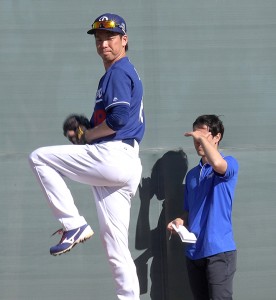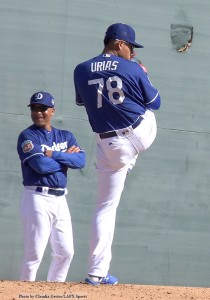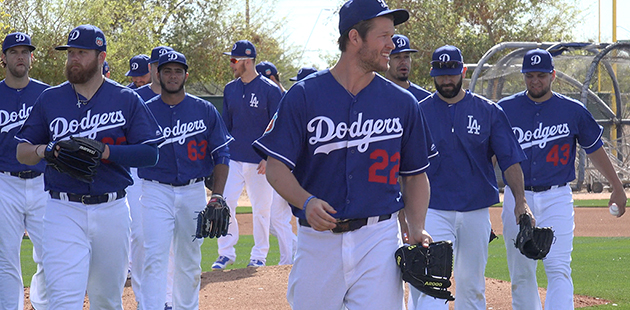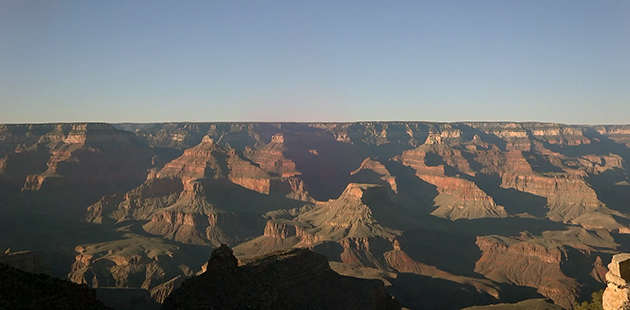Dodgers begin Spring Training
Spring Training has started for Major League Baseball and the Los Angele Dodgers have started their camp in the Cactus League at Camelback Ranch in Glendale, AZ. The first big story from training camp is always the pitching.

Everyone expects Clayton Kershaw to start for opening Day, but new manager Dave Roberts said he hasn’t made up his mind yet, but clearly the Cy Young Award-winning pitcher leads the pitching staff so it would be a great surprise if another pitcher got the start.
With the departure of Zack Greinke, who went to the Arizona Diamondbacks, the Dodgers have a big hole to fill in the rotation. To that end they have acquired several new starters: Cuban Yaisel Sierra has been signed to a six-year, $30 million contract and Kenta Maeda, who was in camp early with other pitchers and catchers. He has an eight-year contract with a lot of incentives that could earn him over $100 million.
Also invited to the Spring Training were two of the Dodgers’ prospects Jose De León and Julio Urías. Catcher A.J. Ellis told our reporter Claudia Gestro he had an opportunity to catch both Urías and De León as well as Maeda and he is impressed with all three.

Claudia Gestro was there and interviewed players and manager Dave Roberts. In this video Roberts and A.J. Ellis talk about some of the pitchers. Roberts explained what’s happening with Korean left-hander Hyun-Jin Ryu, who is expected to return this season.
The big MLB news are the rules changes. It affects the way players can slide not bases if they are trying to break up plays. The runner has to make a “bonafide attempt” to not only get to the base, but to stay on the base as well. They can’t change their path to the base nor can they make contact with the opposing player before they hit the ground in their slide. If the runner makes illegal contact with the infielder, both the runner and the batter will be called out.
The second part of that ruling is that MLB has now essentially done away with the “neighborhood rule.” In the past if the second baseman or shortstop got close to second base on a double play attempt, but didn’t step on the bag while turning the play, the umpires would often give them the out. Now the play is reviewable and the umpires will be instructed to enforce the rule that the infielder needs to tag the base. That is the ruling many players, coaches and managers don’t like. The feel it leaves them open to injuries.

Another rule restricts the amount of time managers and coaches can spend talking to pitchers on the mound. They will now have 30 seconds for their visits to the mound. Some managers take nearly 30 seconds just to make it from the dugout to the mound so that rule will speed things up, or so is the intention. There are exceptions; it only applies to managers and pitching coaches, plus there is no penalty. It will be up to the umpires to “nudge” the managers along.
Batters will be required to keep one foot in the batters box, except with certain exceptions, like when time is called for pitching changes. That is really going to change the way a lot of batters take the plate. So many of them, maybe all MLB batters, have special routines they go through as they prepare to take the batters box and once they are at bat. For the batters that step completely out of the box between pitches, this will be a big change for them.
MLB is hoping this will shorten the games, which were getting to be three hours long — just for the none regulation innings.
Below is Claudia’s video report with Dave Roberts and A.J. Ellis. She contributed to this article.
Photos by Claudia Gestro

We are not the typical news website – nor do we wish to be. We will be offering more than news and blogs, but an opportunity for fiction writers, poets, comedians and musicians to showcase their talent and skills. Much like when the Beatles formed Apple Corps Ltd, they opened the door to all kinds of inspiring talent that never really got a shot. From that came the likes of James Taylor and others. We hope by providing a similar approach we can shine the light on some tremendous undiscovered talent and at the same time offer some familiar voices who live in Los Angeles and beyond.


